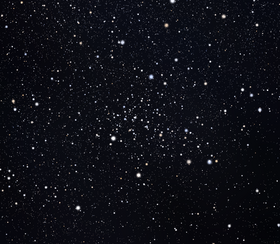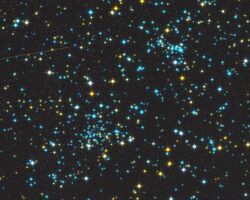Astronomy:IC 4756
| IC 4756 | |
|---|---|
 | |
| Observation data (J2000 epoch) | |
| Constellation | Serpens |
| Right ascension | 18h 38m 31.2s[1] |
| Declination | +05° 29′ 24″[1] |
| Distance | 1.3 kly (400 pc) |
| Apparent magnitude (V) | 4.6[1] |
| Physical characteristics | |
| Other designations | Cr 386, Mel 210 |
IC 4756 is a large bright open cluster in the constellation Serpens. Known as Graff's Cluster, it is bright enough to be seen with the naked eye and considered a fine cluster for binoculars or small telescopes.[2]
IC 4756 is also known as the Tweedledee Cluster (paired with NGC 6633 as Tweedledum), also as the Secret Garden Cluster.[3]
Metallicity of IC 4756 is similar to the Sun, at -0.02±0.01 dex.[4]
Stars
There are some noteworthy stars in the cluster. HD 172365[5] is a likely post-blue straggler in the IC 4756 that contains a large excess of lithium.[6] HD 172189, also in IC 4756, is an Algol variable eclipsing binary[7] with a 5.70 day period. The primary star in the system is also a Delta Scuti variable, undergoing multiple pulsation frequencies, which, combined with the eclipses, causes the system to vary by around a tenth of a magnitude.[8]
References
- ↑ 1.0 1.1 1.2 "IC 4756". SIMBAD. Centre de données astronomiques de Strasbourg. http://simbad.u-strasbg.fr/simbad/sim-basic?Ident=IC+4756.
- ↑ Michael Bakich. "The Omega Nebula, Graff's Cluster, and planetary nebula IC 1295". https://astronomy.com/observing/observing-podcasts/2014/07/the-omega-nebula-graffs-cluster-and-ic-1295.
- ↑ O'Meara, Stephen James (2007). Deep-Sky Companions: Hidden Treasures. Cambridge University Press. p. 457-458. ISBN 978-0521-83704-0.
- ↑ Bagdonas, Vilius; Drazdauskas, Arnas; Tautvaišienė, Gražina; Smiljanic, Rodolfo; Chorniy, Yuriy (2018), "Chemical composition of giant stars in the open cluster IC 4756", Astronomy & Astrophysics 615: A165, doi:10.1051/0004-6361/201832695, Bibcode: 2018A&A...615A.165B
- ↑ "HR 7008 – Star in Cluster". SIMBAD. http://simbad.u-strasbg.fr/simbad/sim-id?Ident=HD+172365.
- ↑ Andrievsky, S. M.; Gorlova, N. I.; Klochkova, V. G.; Kovtyuch, V. V.; Panchuk, V. E. (1999). "The Lithium-rich supergiant HD172365". Astronomische Nachrichten 320 (1): 35–41. doi:10.1002/1521-3994(199903)320:1<35::aid-asna35>3.0.co;2-f. Bibcode: 1999AN....320...35A.
- ↑ Ibanoǧlu, C.; Evren, S.; Taş, G.; Çakırlı, Ö.; Bozkurt, Z.; Afşar, M.; Sipahi, E.; Dal, H. A. et al. (2009). "Spectroscopic and photometric observations of the selected Algol-type binaries - IV. V799 Cassiopeiae, BX Piscium and HD 172189". Monthly Notices of the Royal Astronomical Society 392 (2): 757. doi:10.1111/j.1365-2966.2008.14087.x. Bibcode: 2009MNRAS.392..757I.
- ↑ Costa, J. E. S.; Michel, E.; Peña, J.; Creevey, O.; Li, Z. P.; Chevreton, M.; Belmonte, J. A.; Alvarez, M. et al. (2007). "Pulsational frequencies of the eclipsing δ Scuti star HD 172189. Results of the STEPHI XIII campaign". Astronomy and Astrophysics 468 (2): 637–642. doi:10.1051/0004-6361:20065784. Bibcode: 2007A&A...468..637C.
External links
- IC 4756 on WikiSky: DSS2, SDSS, GALEX, IRAS, Hydrogen α, X-Ray, Astrophoto, Sky Map, Articles and images
Coordinates: ![]() 18h 39m 04.9s, +05° 27′ 09″
18h 39m 04.9s, +05° 27′ 09″
 |


